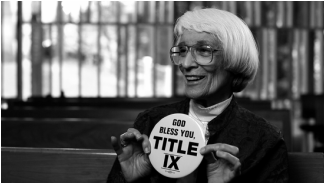To fully appreciate Bernice Sandler's seismic impact on equality for women in higher education, you have to go back to the dark ages of the early 1970s.
In those days, many universities had limits on the number of female professors they would hire. Salaries for female faculty members lagged behind those for men. Men's varsity sports received millions of dollars in funding while female athletes held bake sales to pay for their uniforms. Some women's teams had no locker rooms and had to dress in their dorms.
After living in Bloomington for 9 months, Sandler and her husband relocated to Michigan where they resided for the next six years. With her academic aspirations rekindled, she applied and was accepted into the Social Work program at the University of Michigan as a part-time student. However, after completing a number of courses, she was expected to continue her studies full-time. Sandler was now a mother of two young children and the demanding hours of the program proved to be impractical. Forced to quit, she devoted the next couple of years to raising and nurturing her children and later applied to the University of Michigan’s department of psychology. Unfortunately, she was rejected from their doctoral program.
Bernice Sandler, the "godmother of Title IX" who died Saturday at the age of 90, is being remembered this week for her lifelong fight to reverse decades of institutional bias in U.S. schools and open new paths for women and girls.
It all started in an elementary school in Brooklyn, N.Y., when Sandler was a determined little girl nicknamed Bunny. She was offended by the way the boys got to do all the classroom activities.
"For example, running a slide projector," says Marty Langelan, who was Sandler's friend and colleague for nearly 50 years.
"You know, simple everyday things. You know, 'Oh, we'll have the boys do this.' If it was important, the boys did it," Langelan says. "And she told her mother back then, when she was a schoolgirl, that she was going to change the world, that this was wrong.
"And boy, she sure did."Since it was signed by President Nixon, the law known as Title IX of the Education Amendments of 1972 has charted the evolution of sex equality in America. Initially intended to shatter gender quotas for hiring and admissions, it became a vital weapon against limits on opportunities for women and girls.
"That's the power of Title IX," Sandler told NPR's Tovia Smith in 2014. "It's a hammer that's there, and schools know this and are busy scrambling to change their policies, and that makes me smile."
Title IX has often been associated with college sports, but the statute has a much broader scope. As the Department of Education states, Title IX "applies to 16,500 local school districts, 7,000 postsecondary institutions, as well as charter schools, for-profit schools, libraries, and museums."
Sources: Wikipedia, npr, cnn
Source
Copying/Pasting full or partial texts without adding anything original is frowned upon by the community. Repeated copy/paste posts could be considered spam. Spam is discouraged by the community, and may result in action from the cheetah bot.
More information and tips on sharing content.
If you believe this comment is in error, please contact us in #disputes on Discord